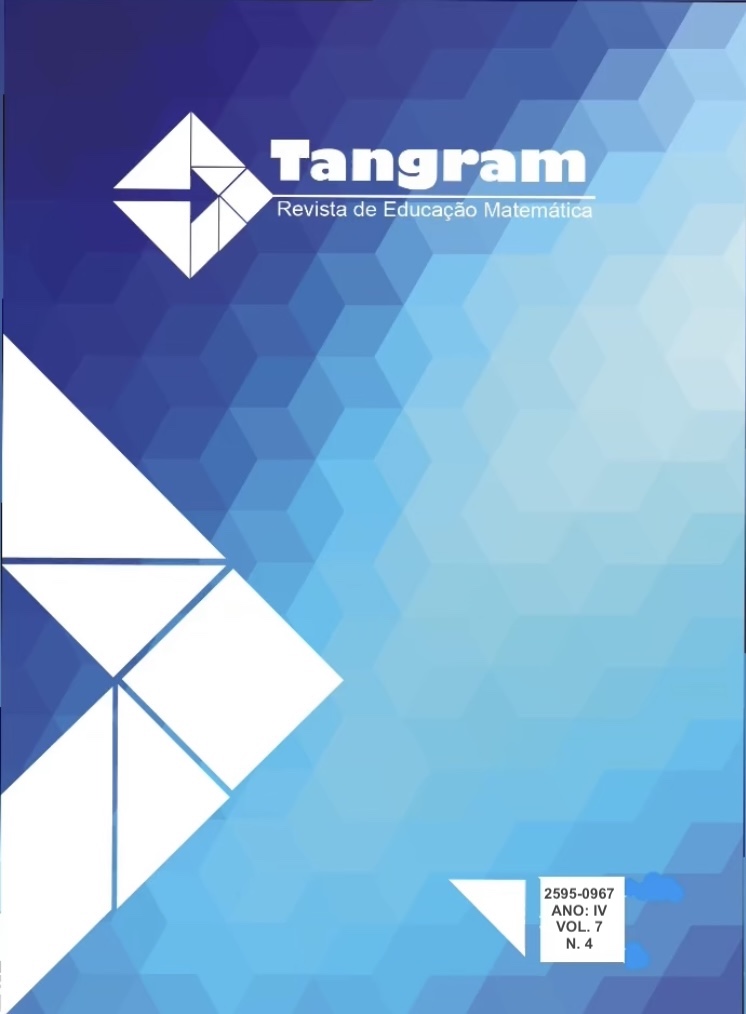GeoGebra-Ferramenta para Explorar Atividades Históricas sobre Números Figurados desde sua Representação Geométrica
DOI:
https://doi.org/10.30612/tangram.v7i4.18280Keywords:
História da Matemática. GeoGebra. Números Figurados.Abstract
This article, the result of qualitative research, of a bibliographic nature, aims to contribute to discussions in the scenario of research developed in Mathematics Education whose theme deals with the possible articulations between the History of Mathematics and Digital Technologies, based on the description of historical activities made possible by the GeoGebra software regarding Figurative Numbers (NF). Thus, the intention is to add new possibilities to this research, based on the use of GeoGebra software, for teaching mathematics based on historical problems, specifically on NF. The theoretical framework on the use of historical problems, elaboration of historical activities and the use of digital technologies in teaching, in particular, GeoGebra, is considered. It is considered that the use of GeoGebra to visualize numerical sequences studied by the Pythagoreans, gains additional character to their algebraic structures from the exploration of their visual character from explorations on computers and/or cell phones.
Downloads
References
Baron, M. E., Bos, H.J.M. (1985). Curso de História da Matemática: origens e desenvolvimento do cálculo. Trad. José Raimundo Braga Coelho, Rudolf Maier e Maria José M.M. Mendes. Brasília: Universidade de Brasília, v.1.
Boyer, C. B. (1974). História da Matemática. São Paulo: Editora da Universidade de
São Paulo.
Brito, A. J.: Lucchesi, D.C; Mendes, I. A.; Miguel, A. (2009). História da Matemática em atividades didáticas (12a ed.) São Paulo: Livraria da Física. Caraça, B. J. (1963). Conceitos Fundamentais da Matemática. Lisboa: Bertrand Ltda.
Cifuentes, J. C. (2005). Uma via estética de acesso ao conhecimento matemático. Boletim GEPEM, Rio de Janeiro, 46, 55-72. DOI: https://doi.org/10.69906/GEPEM.2176-2988.2005.389
Domingues, H.H. (1991). Fundamentos de Aritmética. São Paulo: Atual.
Ferrreira, M. J. A.; Paulo, R. M.; (2018, novembro). A Produção do Conhecimento Matemático ao Estar- Com as Tecnologias Digitais. Anais VIII Seminário Internacional de Pesquisa em Educação Matemática (SIPEM), Foz do Iguaçu, PR, Brasil. Recuperado em: 18 dezembro, 2023, de: http://www.sbemparana.com.br/eventos/index.php/SIPEM/VII_SIPEM/paper/view/539/553.
Gundlach, B.H. (1992). História dos Números e Numerais. Trad. Hygino H. Domingues. São Paulo: Atual. (Tópicos de história da matemática para uso em sala de aula; v.1).
Jankvist, U. T.; Geraniou, E. (2021). 'Whiteboxing" the content of a fonnal mathematical text in a Dynamic Geometry Environment. Digital Experiences in Mathematics Education, [S. 7 (2), 222-246. Recuperado em 14 de abril, 2024, de: https://d0i.org/10.1007/s40751-021-00088-6. DOI: https://doi.org/10.1007/s40751-021-00088-6
Mendes, I. A. (2022a). História para o ensino de matemática: fundamentos epistemológicos, métodos e práticas. Revista Cocar, Belém, 14, 01-21. Recuperado em 16 de abril, 2024, de: https://periodicos.uepa.br/index.php/cocar/afiicle/view/5509
Mendes, I. A. (2022b). Usos da história no ensino de matemática: reflexões e experiências. (3a ed.). São Paulo: Livraria da Física.
Mendes, I. A. (2021). A investigação histórica como agente de cognição matemática na sala de aula. In: Mendes, I. A.; Fossa, J.; Nápoles V. J. E. (orgs.). A história como um agente de cognição na Educação Matemática. Porto Alegre: Sulina, 2006. p. 79-136.
Miguel, A. (1993). Três Estudos Sobre história. (Tese de doutorado). Unicamp, Campinas, SP, Brasil. Recuperado em 15 de novembro, 2018, de: http://repositorio.unicamp.br/handle/REPOSIP/253114. 12(3), 200-209.
Prieto, J. L. (2016) .GeoGebra en diferentes escenarios de actuación. Revista Electrónica Conocimiento Libre y Licenciamiento (CLIO), 14 (3). Recuperado em 16 de abril, 2024, de: https://convite.cenditel.gob.ve/revistaclic/index.php/revistaclic/afiicle/view/866.
Roque, T. (2012). A História da Matemática: uma visão crítica. Desfazendo mitos e lendas. Rio de Janeiro: Zahar.
Saito, F.; Dias, M. S. (2013). Interface entre história da matemática e ensino: uma atividade desenvolvida com base num documento do século XVI. Ciência & Educação, Bauru, 19, (1), 89-111. DOI: https://doi.org/10.1590/S1516-73132013000100007
Saito, F. (2016). Construindo interfaces entre história e ensino da matemática.
Sousa, G. C. (2023). História da Matemática em alianças com Tecnologias Digitais. Revista de Matemática, Ensino e Cultura – REMATEC. Belém/PA,. 44. Recuperado em 10 de abril, 2024 de: https://doi.org/10.37084/REMATEC.1980-3141.2023.n44.pe2023005.id510. DOI: https://doi.org/10.37084/REMATEC.1980-3141.2023.n44.pe2023005.id510
Thomsen, M; Jankvist, U. T.; Clark, K. M. (2022). The interplay between history of Mathematics and Digital Technologies: a review. ZDM Mathematics Education, 54, (1), 1631-1642. https://doi.org/10.1007/s11858-022-01368-0. DOI: https://doi.org/10.1007/s11858-022-01368-0
Vaz, D. A. S; Vásquez, J. C. S.; Vieira, J. D. C. S. (2019). Novas Tecnologias, Novas Demonstrações, Novos Caminhos Para A Matemática E Para A Educação Matemática. Revista de Educação Matemática e Tecnologia Iberoamericana (TEIA), 10 (3). Recuperado em 10 de abril, 2024 de: https://periodicos.ufpe.br/revistas/index.php/emteia/article/view/241388. DOI: https://doi.org/10.36397/emteia.v10i3.241388
Downloads
Published
How to Cite
Issue
Section
License
Copyright (c) 2024 TANGRAM - Revista de Educação Matemática

This work is licensed under a Creative Commons Attribution-NonCommercial-ShareAlike 3.0 Unported License.
Authors must accept the publication rules when submitting the journal, as well as agree to the following terms:
(a) The Editorial Board reserves the right to make changes to the Portuguese language in the originals to maintain the cultured standard of the language, while respecting the style of the authors.
(b) Authors retain the copyright and grant the journal the right to first publication, with the work simultaneously licensed under the Attribution-NonCommercial-ShareAlike 3.0 Brazil (CC BY-NC-SA 3.0 BR) that allows: Share - copy and redistribute the material in any medium or format and Adapt - remix, transform, and create from the material. CC BY-NC-SA 3.0 BR considers the following terms:
- Attribution - You must give the appropriate credit, provide a link to the license and indicate whether changes have been made. You must do so under any reasonable circumstances, but in no way that would suggest that the licensor supports you or your use.
- NonCommercial - You may not use the material for commercial purposes.
- Sharing - If you remix, transform, or create from material, you must distribute your contributions under the same license as the original.
- No additional restrictions - You may not apply legal terms or technological measures that legally restrict others from doing anything that the license permits.
(c) After publication, authors are allowed and encouraged to publish and distribute their work online - in institutional repositories, personal page, social network or other scientific dissemination sites, as long as the publication is not for commercial purposes.






